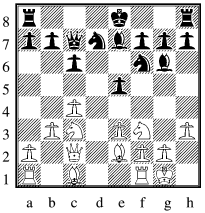
October 2014
Alsager are the jokers in the pack; you just never know what sort of side they will field. Definitely capable of giving bloody noses, their inconsistency means that silverware is more likely to come in the form of a cup than a league title.
With plenty of organisers in their midst, new boys Crewe are likely to be around rather longer than either Hassell or Nantwich before them. With a mix of new names and blasts from the past joining the Crewe based former Holmes Chapel and Alsager players it will be interesting to discover how well matched their entries are to their playing resources. Horses don't come much darker than these.
Fenton like winning. In particular they like winning division four, which they have done in five of the last six seasons. Definitely a danger to the Moorland mob.
It's not quite all change at Holmes Chapel, but surely a season of consolidation in store. Loss of the Crewe based players is bound to have an effect. Rumours that the Blackburns won't be resurfacing there, that Ian Chester has left the area, and that Conor Gay has gone onto higher things (or higher education) would if true represent further setbacks. However their A team is intact and will be a danger in the top division whilst the fortunes of the B team may hinge on selection issues such as how many of the A team want the extra games in division two.
The Kurse of Kidsgrove is that their natural home is in division three, not only the largest division but the one with the greatest number of potential winners. Amusingly the last six winners of the division consist in some order of Fenton A and B and Cheddletons C, D, E and F. Expect Kidsgrove to be in the mix again, but with two Cheddletons, Stafford, Fenton, Meir and possibly others with their eyes on the title, there will be at least one such hopeful finishing in the bottom half of the table.
Given their romp to the division two title last year, any consideration of the outcome of that division should perhaps be called "Who can stop Macclesfield?" The collapse in John-Paul Taylor's grade though I suspect not in his ability means there is effectively room for their team to be even more powerful this year. Ouch.
It is tempting to regard Meir and Fenton as the Potteries Twins. This year each club is fielding one team in each of divisions three and four, and two in division five. Several of each clubs members are up for a pint and a natter. Yet the clubs have been on slightly different trajectories, with Fenton's recent ascendency in the annual pre-season South Potteries Challenge matching their more successful record in the game of hunt the NSDCA silverware. However Meir picked up the division five title last year, so will commence the new season with the confidence of champions, whilst their A team squad looks decidely competitive for a third division team.
Can a club run six teams on less than twenty players? Newcastle have set themselves the task of finding out. Often there or thereabouts in division two, a number of small grade increases will limit the combinations of legitimate top board combinations they can use there this year. Perhaps one of their third division teams will come good instead, but given the number of other teams expecting a good season there, perhaps not. What they won't be doing is playing all their cup fixtures on the designated dates as they don't have enough players to do this. With obvious alternative dates in short supply maybe we'll see a Sunday afternoon match before the season is out.
Stafford have won three of the last four division one title races; their chances of making it four out of five perhaps depend on how Cheddleton split their resources. They are also yet another club with designs on the division three title.
So there you have it. If not Cheddleton, division one will be Stafford, two Macclesfield, four Fenton, five Meir. And three? Time for a sweepstake.
comment on this article
RR's first game of the new season was with white against Alan Paling in the club derby. Not the easiest of starters. We join the game after eleven moves in which a relative non-aggression pact had allowed Alan to equalize.

|
| RR v Alan Paling after 11 ... Bh5-g6 |
12 e4 0-0, 13 Nh4 Nc5 heading for the hole on d4.
14 Nxg6 hxg6, 15 Ba3 Why? the dark-squared bishop is not RR's problem. Be3 to contest the d4 square, or b4 to start queenside play and create some white squares for his problem bishop would surely be better.
15 ... Ne6, 16 Bxe7 Qxe7, 17 Rfd1 Rad8, 18 Rd2 A wasted move. Either swap some rooks oneself, or take the opportunity to move the bishop out of the firing line of the knight arriving on d4. Thus Bg4 offering the bad bishop foe exchange, or Bf1 as a defensive move.
18 ... Rxd2, 19 Qxd2 Rd8, 20 Qe3 Qb4
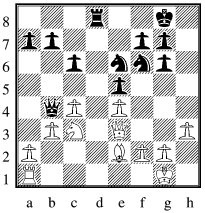
|
| RR v Alan Paling after 20 ... Qb4 |
21 Bd1 b6, 23 a3 Qd6 black now has total control of the d-file
24 Bf3 Nd4, 25 Rd1
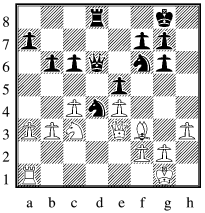
|
| RR v Alan Paling after 23 ... Nd4 |
24 Rd1 Qxa3 oops, there goes the a-pawn
25 Nb1 Qb4, 26 g4 Lashing out. But what else appeals? A good sign that it is time to resign, but as usual RR limps on.
26 ... Qd6, 27 Nc3 Qb4, 28 Bg2 Rd7 Placing it under the protection of the f6 knight so that the b-pawn dies. RR extends the torture past move 40, but there is of course no escape. And whilst there was an obvious blunder in the game leading to an immediate loss of he a-pawn, there is little doubt that the real cause of defeat was the weak moves leaving RR with no play.
comment on this article
An even opening preceded a short sequence of moves in which Clive was able to create and then round up a loose central pawn. But the material advantage wouldn't stick, and at the cost of disruption to his own pawn structure, RR was able to nab two pawns back.
Sounds good, but even by move 20 the game had opposite coloured bishop ending written all over it. Such an ending was duly reached as RR's inability to find active play for his rook resulted in an injudicious king move designed to avoid draw by repetition, loss of a pawn, and exchange of rooks. Inevitably both sides missed chances to gain an initiative in the ending, though the effect of the bishops seemed to be pulling inexorably in the draw direction anyway.
Spoils shared.
comment on this article
The constitution and rules (C & R) consist of all the statements in the original C & R at the foundation of the organisation, adjusted to take full account of all constitutionally agreed additions, deletions and amendments. It is a somewhat abstract entity, that for added clarity I shall sometimes refer to as the C & R as agreed.
Whilst it is possible for anyone to keep track of the agreements to ascertain the current C & R, most organisations find it useful to choose someone to maintain a written version, or C & R as written, the reward for a wise choice being the production of a written version whose content is indistinquishable from the C & R as agreed. Consequently the term C & R can be used without qualifier to refer both to the agreed and written versions. So common is this practice that when confronted with an organisation whose agreed and written versions differ one may forget to clarify which version one is talking about, though context will often make it clear. There can be no doubt however that the real C & R is that as agreed.
A major review of both the rules and the constitution of the NSDCA was undertaken in the year leading up to the 2004 AGM. Relevant documentation from the preceding years was sparse, making it difficult to identify the accuracy of the published Constitution and Rules at that time. Consequently the whole of both documents was put forward to the 2004 AGM for approval, and so can be used as the basis for tracking later changes. Minutes of subsequent meetings clearly show that additions, alterations and omissions have arisen in the documentary version due to non-constitutional working. These errors can and should be rectified at once.
Corrections to the written version to bring it into line with the agreed version do not represent changes to the real C & R, and so do not require any formal procedure. However the necessary will to produce an accurate copy is conspicuous by its absence.
A document outlining the errors which was sent to the secretary can be found here. It also contains other related comments, and so is longer than needed just for this article.
I also sent a mail to the president shortly before the AGM touching on constitutional matters, concluding:
"The league is nominally governed by an executive committee who it would be
reasonable to expect to accept collective responsibility for actions.
However I've no desire to accept such responsibility when such a cavalier
attitude is repeatedly shown towards the constitution. Consequently I
shall not be standing for re-election to the committee or to continue with
the responsibilities of fixtures and results secretaries."
It is extremely useful to be able to point a new captain in the direction of an accurate copy of the rules; unfortunately the written version of both our rules and our constitution seem to have their genesis in the land of the chocolate teapot.
comment on this article
After 36 moves of careful combat in which neither side held a significant advantage at any point, RR's game against David Stothard was heading for a draw. Sometimes you just have to accept that, but RR thought he saw a winning winkle.
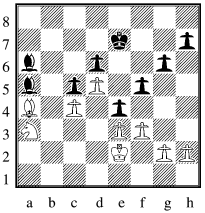
|
| RR v David Stothard after 36 ... Ba6 |
38 Nc2 Who played that? Bxb5
39 cxb5 Kd7 and the b-pawn dies regardless of whether the minor pieces are removed or not. Had I assumed again that he would play a move I wanted - any bishop one rather than Kd7? My brain cells refuse to divulge their thinking at the time. RR squirmed around for another 20 moves, but still scored a blob.
Not defeat from the jaws of victory, but a headbanging performance nevertheless.
comment on this article
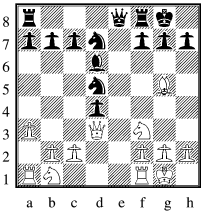
|
| Glyn Ward v RR after 11 Qe2-d3 |
Sample lines after Ne5:
I) 12 Qxd4 Nxf3, 13 gxf3 Qe6, 14 N/R move Qh3, 15 Qh4 Nf4 and the bishop falls to a night fork however white prevents the mate.
II) 12 Qxd4 Nxf3, 13 gxf3 Qe6, 14 N/R move Qh3, 15 f4 and black can simply win the pawn with Nxf4 or look to squash the bishop after protecting hois own knight, as the bishop has no retreats.
III) 12 Nxe5 Qxe5, 13 f4 Qe3+, 14 Qxe3 with both Nxe3 and dxe3 looking attractive
IV) 12 Nxe5 Qxe5, 13 Qg3 Qf5, 14 Qh4 and if there is nothing better to do black can grab the c-pawn and be two pawns up without compensation.
V) 12 Qe4 Nxf3+, 13 gxf3 (Qxf3 and effectively we're back to (IV)) Black protects the knight with c6 or Qd7 before continuing operations against white's kingside weakness.
But theres too much for my poor brain to check that there isn't a line through to comfort or better for white. Which is not to say I shouldn't have played Ne5 anyway.
12 Qxd4 Qf7, 13 Bd2 Ne5, 14 Qe4 c6, 15 Nc3 Nb6, 16 Rae1 Rfe8
17 Nxe5 Bxe5, 18 Qg4 Rad8, 19 Be3
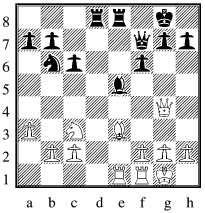
|
| Glyn Ward v RR after 19 Be3 |
20 g3 Bxc3, 21 Bxb6 axb6, 22 Qc4+ With no knight on c6 to block the check and protect c3, white gets to retain a sensible pawn structure. Thus Qc7, lining up queen and bishop against h2, rather than creating a serious threat enabled white to take all the heat out of the game.
22 ... Kf8 23 Qxc3 1/2-1/2
comment on this article
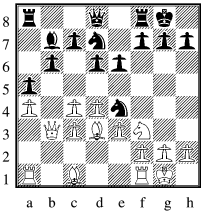
|
| RR v Stephen Ormerod after 11 ... Nd7 |
14 ... f5, 15 Rf2 Qf6, 16 Ba3 Qe7, 17 Re1 Rf6, 18 Qc2 Raf8
19 e4 e5, 20 d5 Both c5 and exf5 would have been better, opening the board, but everyone knows that to avoid a bad bishop you put your pawns on the opposite coloured squares, so here comes another white squared pawn, after which my bishop is doing exactly what? Its going nowhere. Its bad. His bishop on the other hand can harrass my c4 pawn or join in the kingside festivities via c8. And so it proved with RR declaring "Enough!" after move 40:
20 ... f4, 21 Nf1 Rh6, 22 Qd3 Ba6, 23 g3 g5, 24 g4 Nf6
25 Rg2 Qd7, 26 Qc2 Bxc4, 27 Nd2 Ba6, 28 c4 Rh3, 29 Kf2 Kh8
30 Reg1 Rg8, 31 Bb2 Qf7, 32 Qb3 Qf8, 33 Ke1 Qh6, 34 Nf1 Nxe4
35 Qc2 Nc5, 36 Ke2 Qg6, 37 Qxg6 Bxc4+, 38 Kd1 Rxg6, 39 Nd2 Bxd5
40 Rf2 Nd3 0-1
comment on this article
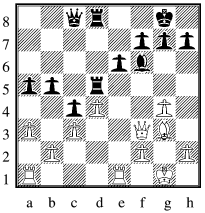
|
| Anthony Foster v RR after 27 ... a5 |
28 ... Bxe5, 29 Rxe5 Rxe5, 30 dxe5 Rd3, 31 Qe4 g6 The move of a man who has been back-row mated before, though in truth the move could wait.
32 Re1 Rd2, 33 Re2 Qd8, 34 Rxd2 Qxd2 In one sense it is understandable that white initiates this exchange as it frees his queen to whizz around the board, but his queen is still needed for defensive purposes even after the exchange. Perhaps he should have applied the rule "when winning swap pieces, when losing swap pawns" and have looked at a4 as a way of achieving this.
35 Qa8+ Kg7 ,36 Qf3
If white takes the a-pawn he loses two rather more important ones:
36 Qxa5 Qd1+, 37 Kg2 Qxg4+, 38 Kf1 Qd1+, 39 Kg2 Qd5+, 40 Kg1 Qxe5
36 ... Qe1+, 37 Kg2 Qxe5
A pawn dies anyway, and RR soon exchanges queens to reach an easily won king and pawns ending. A win at last!
comment on this article
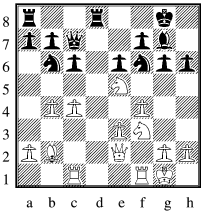
|
| RR v Michael Connor after 15 ... Nd7-b6 |
19 Rb1 Qe7, 20 Qc2 Nc5 and in due course "lose pawn, lose game" was in this instance proven true.
From which description you'll probably have gathered that RR had other resources available to him. With the black queen and knight enjoying themselves on the queenside white should look for entertainment in the centre or on the kingside. Starting with 19 f5 a credible line would be:
19 f5 exf5, 20 exf5 g5, 21 Nxf7 Re8, 22 N3e5 and white has a big attack as well as the pawn back.
(21... Kxf7, 22 Qe6+ with the other knight coming into g6 via e5 is too horrible to contemplate for black.)
Indeed had RR blocked the check with c5 on move 18, as well as the kingside attack plan which would still have been available and strong, he could also have chosen
18 c5 Qxb4, 19 Rc4 Qa5, 20 Qc2 b5, 21 cxb6 Nxb6, 22 Nxc6 and white has the pawn back and better piece co-ordination.
Without either player realising it at the time, the b4 pawn was poisoned.
comment on this article
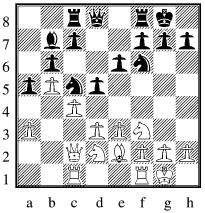
|
| RR v Kasik Wozniak after 14 ... Rc8 |
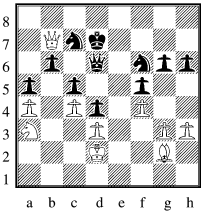
|
| RR v Kasik Wozniak after 54 Qb7 |
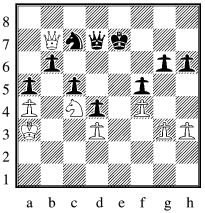
|
| RR v Kasik Wozniak after 67 ... Qd7 |
More ducking and diving sees us reach move 68 with RR somehow ahead. Qxb6 with another pawn to follow and RR's pieces are better placed. However this time he succeeded in losing with
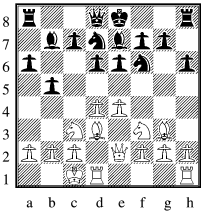
|
| Phil Birks v RR after 10 ... b5 |
11 e5 Nd5, 12 Nxd5 Bxd5, 13 c4 Brave man. doesn't this help my attack?
13 ... bxc4, 14 Bxc4 Bxc4, 15 Qxc4 d5, 16 Qc6 All fairly natural, though I confess the white queen is uncomfortably close to my king. Time for a swift exit:
16 ... O-O, 17 h4 Looks like there will no quiet life for the black king even after castling, but surely my queenside play should be quicker. Rb8 and Rb6 must be right, but somehow I convince myself that a slower manoeuvre is superior.
17 ... Nb6, 18 Kb1 Rb8, 19 Nd2 Qc8, 20 Rc1 Na8 Yes, unable to get his knight to e8 to defend the c7 pawn, RR uses the corner instead. About the only virtue of this is that it has a 'red rag' element, tempting Phil to contest the queenside further.
21 Nb3 Rb6, 22 Qc2 Qd7, 23 Rh3 Qb5 No. The f-rook is doing nothing. Rfb8 has to be better.
24 Bf4 a5, 25 Ka1 Is this not a waste of time? How is black breaking through? a4 knight moves, a3 b3, and then? Much better is a switch of focus with Rg3. With bishop hitting h6, queen h7 and the c-rook ready to join in the fun via h1 blacks survival would be far from assured. However both players are convinced the game will be decided on the queenside, so continue to ignore kingside possibilities.
25 ... a4, 26 Nc5 Rc6 diagram right

|
| Phil Birks v RR after 26 ... Rc6 |